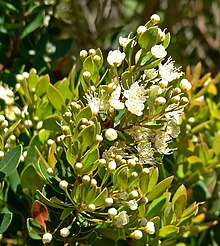bio.wikisort.org - Plant
Amomyrtus is a genus of flowering plants in the myrtle family, Myrtaceae described as a genus in 1948.[1][2] It is native to temperate southern South America, where it is distributed in Chile and Argentina.[3][4]
| Amomyrtus | |
|---|---|
 | |
| Amomyrtus meli | |
| Scientific classification | |
| Kingdom: | Plantae |
| Clade: | Tracheophytes |
| Clade: | Angiosperms |
| Clade: | Eudicots |
| Clade: | Rosids |
| Order: | Myrtales |
| Family: | Myrtaceae |
| Subfamily: | Myrtoideae |
| Tribe: | Myrteae |
| Genus: | Amomyrtus (Burret) D.Legrand & Kausel |
These plants produce large, white flowers with abundant pollen and fleshy black fruits containing one to three seeds. The plants are self-compatible.[4]
Species
Species[3]
| Image | Scientific name | Description | Distribution |
|---|---|---|---|
 | Amomyrtus luma (Molina) D.Legrand & Kausel, | a shrub or tree | the humid forests of Chile and Argentina |
 | Amomyrtus meli (Phil.) D.Legrand & Kausel, | a large tree | the rainforests of Chile |
References
Wikimedia Commons has media related to Amomyrtus.
- Legrand, Carlos Maria Diego Enrique & Kausel, Eberhard Max Leopold. 1948. Lilloa 13: 145
- Tropicos, Amomyrtus (Burret) D. Legrand & Kausel
- Kew World Checklist of Selected Plant Families
- Arroyo, M. T. K. and A. M. Humaña. (1999). Breeding systems of two endemic rainforest species in southern Chile: Amomyrtus meli (Phil.) Legr. et Kaus. (Myrtaceae) and Luzuriaga polyphylla (Hook.) Macbr. (Philesiaceae). Archived September 21, 2013, at the Wayback Machine Guyana Bot 56(1) 31-37.
На других языках
- [en] Amomyrtus
[es] Amomyrtus
Amomyrtus es un género de plantas con dos especies, perteneciente a la familia Myrtaceae. Es natural de Chile y Argentina[1]Текст в блоке "Читать" взят с сайта "Википедия" и доступен по лицензии Creative Commons Attribution-ShareAlike; в отдельных случаях могут действовать дополнительные условия.
Другой контент может иметь иную лицензию. Перед использованием материалов сайта WikiSort.org внимательно изучите правила лицензирования конкретных элементов наполнения сайта.
Другой контент может иметь иную лицензию. Перед использованием материалов сайта WikiSort.org внимательно изучите правила лицензирования конкретных элементов наполнения сайта.
2019-2025
WikiSort.org - проект по пересортировке и дополнению контента Википедии
WikiSort.org - проект по пересортировке и дополнению контента Википедии